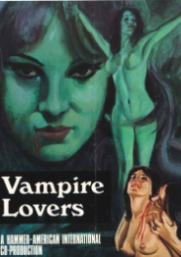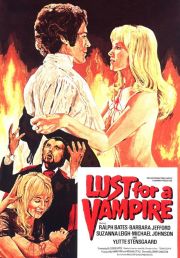The Karnstein Trilogy: The Vampire Lovers, Lust For a Vampire, Twins of Evil
The Devil Says
See 2 out of 3
As the ‘70s hit, the feral vampire had run its course, and Hammer turned toward the sensual ones. Based on Sheridan’s Le Fanu’s Carmilla, The Karnstein Trilogy introduces us to female vampires who feed via seduction and bare breasts. While they are willing to take any victim, their main prey are young beautiful women.
Hammer Horror pleases the Devil with it’s sumptuous colors, gothic feel, and sensual tones. I’m less thrilled with their tendency toward simplistic scripts, insufficient budgets, and poor effects. But the real problem is their conservative, puritan morality: God, or at least religious observance, is good; sex is bad; lesbianism is an abomination (although it is a lot of fun to watch, if only briefly); and the old social class structure is for the best. That is more than usually on view in The Karnstein Trilogy. Besides the not-uncommon horror cinema message of “sex is depraved and… Oh look, tits!” The Karnstein Trilogy bizarrely pushes for a social hierarchy that almost all of British cinema had been opposing since the start of WWII. Yes, the rich and powerful are the source of evil, but also the source of good, as they are the only ones that count. Peasants, those grubby working class types, are best ignored. They are uncouth and their deaths are rarely of real significance. This aspect of Hammer is largely missed across the pond, but in England, where status and class had meant everything for hundreds of years, it is a visible thorn. As for the anti-lesbian focus, it would admittedly be difficult to make Carmilla with a pro-lesbian message, but for films where the main selling point was girls kissing girls, I’d have put some effort into it.
Against those negatives, we do have lovely gothic visions. All three films use color beautifully and display Hammer’s mastery of sets and costumes. And all three have a good deal of female flesh on display that is worth your time to ogle.
The Vampire Lovers
The Devil Says
See It
(For the breasts)
The first Hammer film where low-cut heaving bodices were replaced by bare breasts, the poorly named The Vampire Lovers (so, just who are the title characters?) doesn’t make a lot of sense, but it is fun to look at.
At General Spielsdorf’s (Peter Cushing in a long cameo) ball, an
unexplained countess is brought a message from an even more
unexplained horseman that she must rush off. She leaves her
beautiful daughter, Marcilla (Ingrid Pitt), in the care of the
general who happens to have a hot daughter. The daughter begins
having nightmares to go with her obsession with their house
guest and soon after dies. The death upsets Emma (Madeleine
Smith), another hot daughter, this time of wealthy Roger Morton
(George Cole).
 When a carriage breaks down near Morton’s estate,
Morton volunteers to take in the younger occupant, Marcilla now
calling herself Carmilla. Subdued lesbian antics ensue.
When a carriage breaks down near Morton’s estate,
Morton volunteers to take in the younger occupant, Marcilla now
calling herself Carmilla. Subdued lesbian antics ensue.
I can’t imagine the tactic of needing to be left behind by a harried relative with a widowed land owner who happens to have a sexually desirable daughter would work many times. It seems unlikely Carmilla could have survived for over two hundred years using that plan. But while it works, go for it.
The stars of the picture are the breasts. They are quite lovely, as breasts often are, so I commend the fine casting. There’s a story that kept me engaged, but it exists to frame the breasts and the mainly implied lesbianism. Without those, I’d have been trying to make sense of the plot, and this is not a film that can withstand that. Thinking will definitely get in the way.
Even with those breasts I couldn’t help long for a protagonist. The movie never settles on whose story it is telling. Emma is the obvious choice, but she doesn’t do anything but look adorable and become a treat for Carmilla. Which would lead me to next choose Carmilla, but we’re seldom given any insight into her. She’s to be observed, not understood. I’d have liked for it to be the governess, played by the hypnotically attractive Kate O’mara. She shows signs of being the rarest of Hammer horror entities, a strong female, but that fades away quickly. It doesn’t hurt that O’mara puts in the best performance in the picture. Since it is a Hammer film, the only ones with agency are the men: the general, Morton, the underdeveloped lover, the butler, and the vampire-hunting Baron, but none get enough screen time. In the end, there’s no real lead except for Ingrid Pitt’s breasts, but they are spectacular.
 For all my talk of breasts, you might be expecting more nudity
then you get. For a lesbian vampire tale, I was certainly
expecting more lesbianism. There’s more female frolicking and
gazing then licking and moaning. Which does point to an error in
casting. Yes, they did right because the breasts are the starts,
but the main actresses connected to those breasts are too old.
Marcilla/Carmilla would have worked better if she’d appeared to
be around eighteen instead of Pitt’s thirty-three. Shirley Eaton
was rejected for the part as being too old, but she was the same
age as Pitt, and had aged equally well. And Emma’s behavior
would be more fitting for a young teen, though neither 1970s nor
2010s audiences are ready for a lesbian relationship between a
young adult and a fourteen-year-old.
For all my talk of breasts, you might be expecting more nudity
then you get. For a lesbian vampire tale, I was certainly
expecting more lesbianism. There’s more female frolicking and
gazing then licking and moaning. Which does point to an error in
casting. Yes, they did right because the breasts are the starts,
but the main actresses connected to those breasts are too old.
Marcilla/Carmilla would have worked better if she’d appeared to
be around eighteen instead of Pitt’s thirty-three. Shirley Eaton
was rejected for the part as being too old, but she was the same
age as Pitt, and had aged equally well. And Emma’s behavior
would be more fitting for a young teen, though neither 1970s nor
2010s audiences are ready for a lesbian relationship between a
young adult and a fourteen-year-old.
Sins (What does this mean?)
| Pride | Nada. |
| Sloth | These folks spend a lot of time just laying about and it seems pretty nice. |
| Avarice | Life’s a bit better when your home is beautiful, your clothing is of the highest quality, and you seldom have to work and never physically. The General and Morton have a lot of nice stuff. |
| Gluttony | They all indulge as they please, though there is little focus on it. |
| Wraith | Wraith is what motivated the Baron to kill the vampire many years ago and what allows the general to overcome his squeamishness now. |
| Beauty | The film is pretty to look at and the women even prettier. |
| Thought | Nothing here. |
| Humor | We’re low on jokes and nothing promotes humor. These folks would lead better lives if they laughed more often. |
| Lust | This is a mixed one. The basic lesson of the film is that sex is bad and lesbian sex is evil and must be stopped. All the suffering comes with lesbianism and is stopped when the lesbianism stops. Emma is saved when she falls into the (non-lustful) arms of a man. The governess is doomed because she cannot overcome her lesbian impulses. But to counter that, the feature sells sex. That’s what it exists for. While there is only limited screen time devoted to nudity and carnal activities, almost every scene revolves around eroticism. As for that nudity, we get bare or gauze-covered nipples from three of the major female characters as well as from an extra and a pair of brief pubic hair shots. There’s a good deal of caressing and a few kisses, though the three lesbian relationships and one heterosexual one are consummated off screen. |
Lust For a Vampire
The Devil Says
See It
(But don't put any effort into it)
Forty years after the events of The Vampire Lovers. the Karnsteins are back. With a goblet filled with a virgin’s blood and a call to me, Carmilla (now played by Yutte Stensgaard) is resurrected. I’d like to point out that I have no interest in virgin blood nor do I resurrect vampires so I have no idea who they were praying to, but it wasn’t me.
While the local townspeople fear vampires, that’s not the case for the inhabitants of the new and isolated finishing school where only the prettiest girls romp about performing roman dance. Novelist, skeptic, and desperate for a date Richard LeStrange (Michael Johnson) gets himself a job there teaching literature with plans to get him some hot vampire girl action. You might think that’s a terrible plan, but he does succeed, so, points to him.
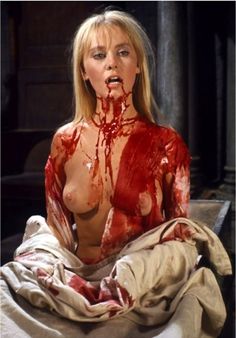 Hammer continues its rich, gothic romantic
style. It also continues its run of questionable scripts,
beautiful women too old for their parts, and characters that
don’t make a lot of sense. And from the previous film, it
continues the display of breasts.
Hammer continues its rich, gothic romantic
style. It also continues its run of questionable scripts,
beautiful women too old for their parts, and characters that
don’t make a lot of sense. And from the previous film, it
continues the display of breasts.
Hammer had been moving toward more overt sexuality and here the erotic elements far surpass the horror ones. But then Hammer was never all that frightening, and Lust for a Vampire is quite lusty. Sometimes director Jimmy Sangster overshoots, particularly with girls licking their lips before kissing the air right below the camera lens. But at other times he manages quite well. If you like your vampires cute and sexy, with a tendency to lose their tops, this is your type of film. Though this is a boarding school film, so those bare breasts are more likely to pop out in giggling “girls-being-girls” moments than due to vampire lust.
For the characters being nonsense, they are a lot of fun. Miss Simpson is an absurd—nearing wacky—school mistress. Carmilla is sensual and Yutte Stensgaard manages to make her sympathetic. And LeStrange is an idiot whose personality wanders with the needs of the script, but that doesn’t mean his foolishness isn’t amusing. Besides, that fits him into the long tradition of idiot Hammer leads. If a Hammer character isn’t played by Peter Cushing, chances are he’s going to be making a whole lot of bad decisions. Janet, the unsuccessful love interest, makes no more sense than the rest of them, but it’s a relief for a Hammer woman to exist who doesn’t spend all her time screaming and fainting.
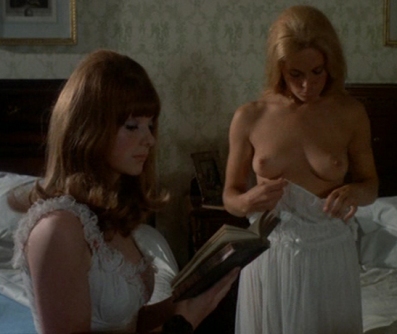 Not everyone at Hammer actor was thrilled
with the picture. Ingrid Pitt refused to return as the lead
vampire due to the weakness of the script. Ralph Bates (as the
info dumping school co-founder) called it his least favorite
film. And I’m sure Mike Raven (Count Karnstein) wasn’t thrilled
to find out his voice had been dubbed, and dubbed poorly. I
can’t blame any of them for being disappointed. The plot is a
colander. And who are the two elder Karnsteins and why do they
leave all the biting to Carmilla?
Not everyone at Hammer actor was thrilled
with the picture. Ingrid Pitt refused to return as the lead
vampire due to the weakness of the script. Ralph Bates (as the
info dumping school co-founder) called it his least favorite
film. And I’m sure Mike Raven (Count Karnstein) wasn’t thrilled
to find out his voice had been dubbed, and dubbed poorly. I
can’t blame any of them for being disappointed. The plot is a
colander. And who are the two elder Karnsteins and why do they
leave all the biting to Carmilla?
OK, so the story doesn’t stand up, but if you like rich colors, pretty girls, and lots of dry ice, this movie has you covered. It also isn’t rooted in conservatism as the other two Karnstein films. Yes, only the upper class maters, but they are all idiots. There’s no overriding message about God or lesbianism, so, it is easier to enjoy the breasts.
Sins (What does this mean?)
| Pride | Nada. |
| Sloth | There’s a good deal of laying about but it is unclear if anyone enjoys it. |
| Avarice | The upper and middle classes have it over the peasants, though it isn’t clear why. |
| Gluttony | The pub is the only place where peasants can find any happiness. |
| Wrath | Nope. In fact the opposite. Only Miss Simpson manages to channel Wrath in a positive way. It is unhelpful for the constable and causes Lestrange and the townspeople to take some majorly stupid actions. |
| Beauty | There are a lot of beautiful women and several of them display that vividly, but that’s about it. It isn’t a good looking film by Hammer standards. |
| Thought | There is the promotion of the sin of Thought in what should have been. The townspeople’s attack is doomed to failure because they aren’t thinking. |
| Humor | There are several clown-type characters but nothing all that funny. |
| Lust | Like in most Hammer productions, Lust, and sex of any kind, is a bad thing. It is Lestrange’s Lust that causes him to fall for a vampire, which is rarely a good idea. But the moralizing is toned down from the previous film. But also toned down is the eroticism. We get as many bare breasts they are offered up in a more off hand way—girls changing clothes or going swimming. While Carmilla still seduces her victims, it is no longer the main theme, but just something that happens, normally briefly, and mostly off screen. |
Twins of Evil
The Devil Says
Skip It
The last and least of The Karnstein Trilogy, Twins of Evil jettisons the erotic fun of the first two in order to get in on the growing Inquisition/torture film movement. It’s still early ‘70s Hammer, so the torture is pretty light, but the tone is grim and the moral is horrendous.
Times have changed at Karnstein castle. Between films, the place has been rebuilt. It was a ruins and then a burning ruins, but now it’s gothic chic. The vampires are also gone, so whoever those two elder vamps were at the end of the last film, they’ve apparently gone off on a vacation, and left the place to an unknown human relative, who is well respected by the Emperor.
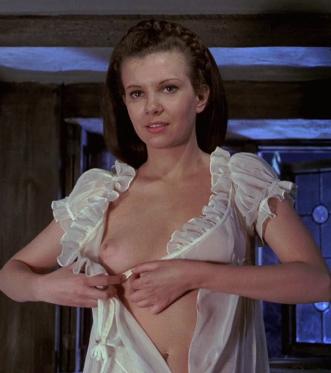 Thing have also changed in the village, which is now run by
puritan witch hunters lead by Gustav Weil (Peter Cushing). Since
there are no actual witches, they burn innocent girls while
chanting about the glory of God. Enter Gustav’s two recently
parentless nieces (Mary and Madeleine Collinson), who are used
to a less gloomy world.
Thing have also changed in the village, which is now run by
puritan witch hunters lead by Gustav Weil (Peter Cushing). Since
there are no actual witches, they burn innocent girls while
chanting about the glory of God. Enter Gustav’s two recently
parentless nieces (Mary and Madeleine Collinson), who are used
to a less gloomy world.
Seems we have our setup. The evil ones are the murdering, cruel churchmen and justice will come due to some interaction of the twins and the to-be-resurrected vampire. Well, no. The fanatics who burn innocent young girls at the stake—they are the good guys.
It seems Count Karnstein is a slimy guy. Lecherous and bored, he caries out a Satanic ritual, killing a peasant girl, and resurrecting Mircalla (sometimes known as Carmilla). She turns the count into a vampire and promptly exists the movie. He sets out to do evil, and somehow his biting girls and killing them is far worse than the fanatics burning them. Hey, they mean well, and isn’t that enough?
The twins are our gauge for “true” morality. Yes, the puritans are the good guys, but they have taken things too far. It’s the girls we, the audience, are supposed to take as our guide. Maria is weak and submissive. She’s easily frightened and her greatest fear is that she might upset someone. The fact that the someone is a scum ball doesn’t matter to her. She knows her place in society and that’s what is important. Frieda is rebellious and wants to be free. That makes her bad, so naturally, she’s nasty to her sister for no good reason and runs off into the arms of the count and becomes a vampire.
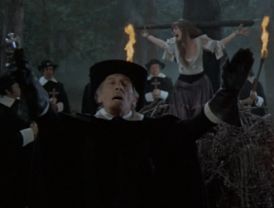 The remaining major character is boar hunter and choirmaster
Anton, who’s bothered by innocent girls being burned, but not
nearly as much as he is by vampires.
The remaining major character is boar hunter and choirmaster
Anton, who’s bothered by innocent girls being burned, but not
nearly as much as he is by vampires.
I’d like to think that a movie could be satisfying at some level, but unless you are an old school fundamentalist Christian, there’s no good to be had here. Unchristian evil is punished while Christian evil is encouraged, if suggested to be tempered. Freedom is frowned upon. Fawning submission is rewarded. I could excuse the screwed up message if the whole thing was fun, with gratuitous sex and violence, but Twins of Evil aims for cruelty and unpleasantness, without willing to go all the way as more gruesome inquisition films already had. Considering the Collinson sisters greatest claim to fame is as the first twins to be featured in a Playboy pictorial, I’d expect a lot more of their skin to be on display.
Twins of evil is a distasteful little film. There wasn’t the will to go balls to the wall, so instead of truly offending someone, which would give it some reason to exist, it is a timid little nasty work.
Sins (What does this mean?)
| Pride | Nada. |
| Sloth | The film is anti-sloth, though it’s hard to rate the twins and other younger women really doing much at their school. The only one who lounges about is Count Karnstein, and he doesn’t enjoy it. |
| Avarice | Not much. It is better to be in the middle class as then you get to do the burning instead of being burnt, but that’s as good as it gets. Count Karnstein is the only one who owns pretty things, and like his lounging, he doesn’t enjoy them. |
| Gluttony | Again, only the Count indulges. See Sloth and Avarice. |
| Wrath | Wrath only seems to motivate people to do cruel and stupid things. On the surrogate cruelty front, there are multiple girls burned alive, but not in any way to be of interest. |
| Beauty | For Hammer, it isn’t a particularly good looking film. |
| Thought | Thinking is promoted as it is thought and study that show you how to destroy evil, not just fanaticism. So thought trumps mindless devotion. I suppose that’s something. |
| Humor | Nada. This is a humorless flick. |
| Lust |
More than most Hammer films, this one is
anti-lust. Count Karnstein, when still human, the only
one engaged in anything lusty, and he’s both bored and a
slime ball. Frieda has some lustful inclinations, and
that leads her to vampirism and evil. Anton’s initial
feelings of lust makes him ignore the good girl he’s
suppose to be interested in and go for the one he
shouldn’t. I’d skip them both. Those girls are in need
of therapy. For the audience, it is little better. We see a bit of skin from the sacrificial girl, the vampire twin opens her nightgown, and a silly sex scene where the camera focuses on Mircalla stroking a candle. This is a fetish that’s new to me. |


